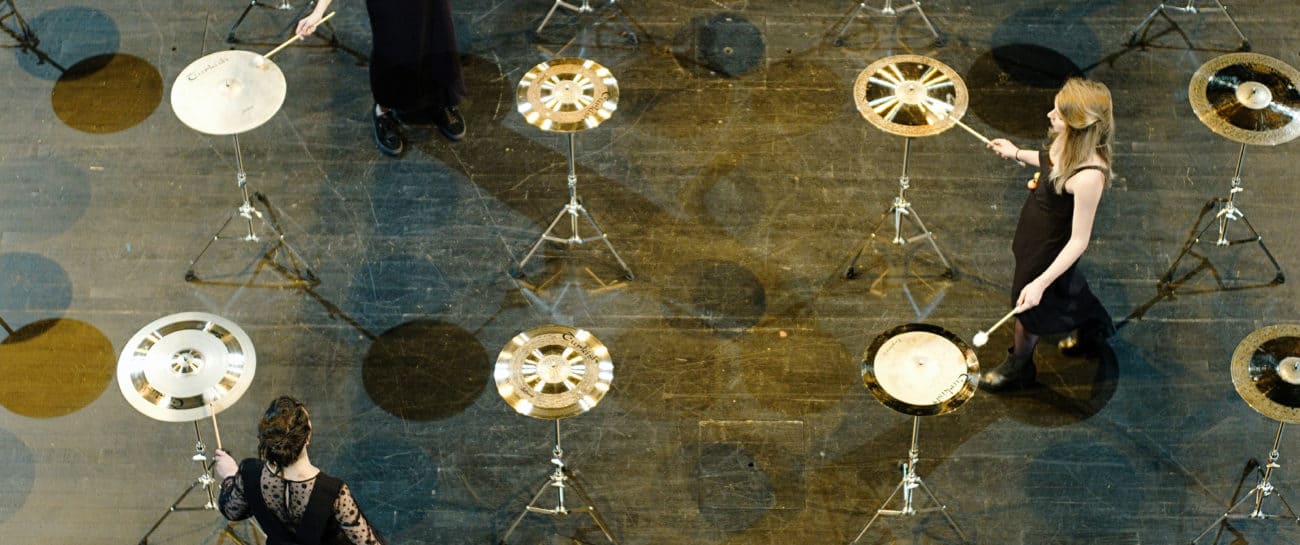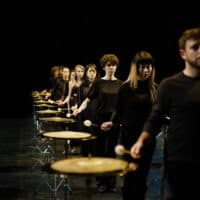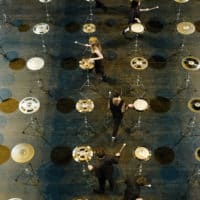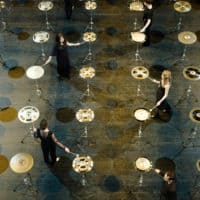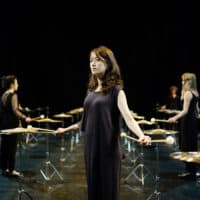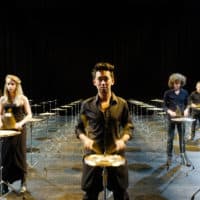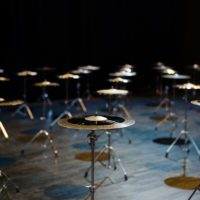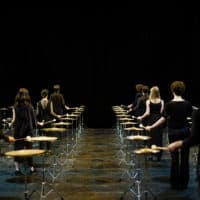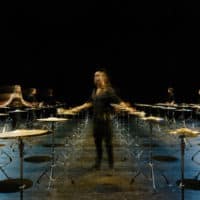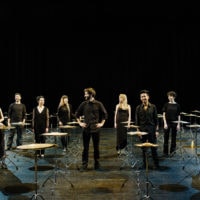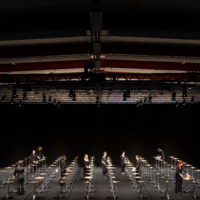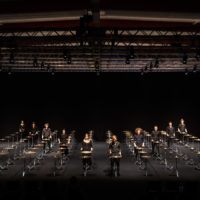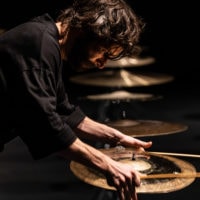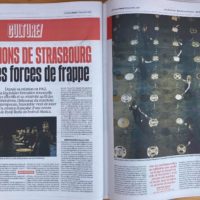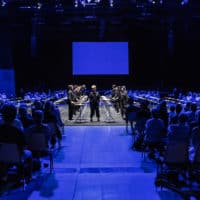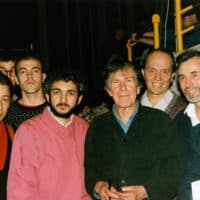John Cage / Ryoji Ikeda But what about the noise of crumpling paper (1985 / 2021) 15’
Ryoji Ikeda 100 cymbals (2019) 35’
Musicians : The Percussions de Strasbourg – Alexandre Esperet, Léa Koster, Emil Kuyumcuyan, Olivia Martin, Minh-Tâm Nguyen, François Papirer, Lou Renaud-Bailly, Thibaut Weber, Hsin-Hsuan Wu, Yi-Ping Yang
Coproduction : Les Percussions de Strasbourg / Festival Musica / KunstFestSpiele Herrenhausen
With the special help of Yamaha and Turkish cymbals
“Ten silhouettes dressed in black circulate in the middle of a copper mushroom field. Without superfluous gesture, without any muscle in their faces altering their neutrality, they make 100 cymbals resonate at waist height […]. 100 cymbals, a piece by Ryoji Ikeda, a contemporary music guru with rare public appearances, is just enough to express what a cymbal can. The audience imagines a chaotic hubbub of hammering crashes, with arrhythmic drummers pounding the metal like a nail. Not at all. It’s all about sweetness: a light drone with changing harmonics caresses their eardrums like a cottony violin or synth layer. There is even vocality in the call of the brass, almost a song. The cymbal, this instrument of delicacy. “
Guillaume Tion, Libération, Sept. 29, 2020
With 100 cymbals, Ryoji Ikeda dives us into the abyss of vibration. A unique listening experience.
Created in 2019 at the Los Angeles Philharmonic, in the sumptuous hall designed by architect Frank Gehry, 100 cymbals is as much a stage performance as an audiovisual installation. Ryoji Ikeda highlights the rich potential of cymbals by following the thin line between noise and harmonic resonance. The seemingly rudimentary instrument, a convex disc made of an alloy of copper, brass and bronze, which is more commonly used to accentuate certain times of the measure, is transformed into a powerful polyphonic resource. The different modes of playing, more or less conventional, maintain a fusional – almost choral – sound and allow harmonic strata and other acoustic results to emerge within a process that a simple line could represent: an infinite crescendo, leading from an almost imperceptible murmur to the brilliance of the final fortississimo.
The concert opens with a sound portrait that John Cage dedicated to Hans Arp of Strasbourg on the occasion of the centenary of his birth. The American composer considered the co-founder of the Dada movement as a model, especially for his relationship to nature and his cosmogonic conception of art. The result is this conceptual, machine-typed score offered to the Percussions de Strasbourg in 1986, in which the musical language is reduced to five typographical signs. A minimal work, made of environmental rustlings, which in the same way as 100 cymbals, solicits a deep listening.
Ryoji Ikeda had already signified his filiation with John Cage with a plastic version of the famous 4’33”, in the form of a painting made of a 16 mm film. For this new work on the father of musical experimentation, Ryoji Ikeda has chosen to replace the elements initially used such as wood, water, glass or metal by instruments from Japanese culture. Similar to two rectangular pieces of wood that are slammed or rubbed together, hyōshigis are traditionally used during certain ritual or daily ceremonies in Japan. Here, with no effects or microphones, the sound unfolds only in the form of impulses or rubbing, in a precise gesture of acoustic purity. The simplicity and reduction of materials, combined with subtle variations, reveals the compositional structure of the piece. The stripping down of sonorities to white noise or delicate frictions of wood highlights the special place given to silence in John Cage’s work, as well as to the natural environment and the different rhythms of water that the artist mentioned in his score: “Arp was stimulated by water (the sea, lakes, running water such as river water) and forests.”
On tour:
- 17 September 2020 : Festival Musica, Strasbourg (French premiere)
- 3 & 4 June 2021 : KunstFestSpiele Herrenhausen, Hannover, DE
- 3 March 2022 : Le lieu unique, Nantes, FR
- 25 March 2022: MaerzMusik, Berlin, DE
- 08 April 2022 : Rewire Festival, The Hague, NL
- 24 June 2022 : GRAME – Pôle Pixel, Villeurbanne, FR
- 4 september 2022 Festival Sacrum Profanum, Krakow, PL
- 19 November 2022: Tromp Percussion Competition, Eindhoven, NL > cancelled
- 26 November 2022: Cité de la musique, Philharmonie de Paris, FR
- 3 March 2023: Festival Musika-Música, Bilbao, ES
- 14 April 2023: Musiekgebouw, Amsterdam NL
- 21 July 2023: Foundation Gulbenkian, Lisbon, Portugal PT
- 23 July 2023: Foundation Serralves, Porto, Portugal PT
- 7 April 2024: Hellerau, Dresden, Germany DE
Downloads
Stage plan 100 cymbals 15m x 15m for TR
Light plot type 100 cymbals v2
Program 100 Cymbals Philharmonie of Paris 26.11.2022

